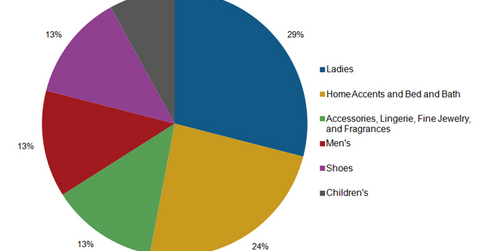Key Components of Ross Stores’ Sales Mix
In fiscal 2014, women’s apparel accounted for 29% of Ross Stores’ sales of $11 billion. Home accents is also a key category at 24% of total sales.
Oct. 23 2015, Published 3:26 p.m. ET

Revenue sources
Ross Stores (ROST) derives its revenue from the sales of apparel for men, women, and children, as well as accessories, footwear, jewelry, and home merchandise. The women’s apparel and home accents categories are two of Ross Stores’ largest sales sources.
Sales mix
In fiscal 2014 ended January 31, 2015, women’s apparel accounted for 29% of the company’s total sales of $11 billion. Men’s and children’s apparel accounted for 13% and 8%, respectively, of fiscal 2014 sales. Accessories, lingerie, fine jewelry, and fragrances together accounted for 13% of fiscal 2014 sales. Footwear contributed 13% of Ross Stores’ sales in fiscal 2014.
The portfolio holdings of the iShares U.S. Consumer Services ETF (IYC) and the iShares Global Consumer Discretionary ETF (RXI) have 0.7% and 0.5% exposure, respectively, to Ross Stores.
Home accents: a key category
Home accents and bed and bath is also a key category for Ross Stores’ sales mix. This category accounted for 24% of Ross Stores’ fiscal 2014 sales. Home merchandise is an important source of revenue for the company’s peers as well.
Leading off-price retailer TJX Companies (TJX) derived 29% of its sales from home merchandise in the fiscal year ending January 31, 2015. Home goods accounted for 12% and 16% of fiscal 2014 net sales of department stores JCPenney (JCP) and Kohl’s (KSS), respectively.
With the improvement in the US housing market, the demand for home merchandise has improved. In the first half of fiscal 2015 ended August 1, 2015, the proportion of Ross Stores’ sales derived from home accents and bed and bath increased to 23% from 22% in the comparable period of the previous year.
Target consumer
The target consumer of Ross Stores is the American middle class. Generally, Ross Dress for Less stores are located in markets with a large proportion of middle-income households.
The target customer for dd’s DISCOUNTS stores is generally younger and belongs to households with more moderate income levels compared to the Ross Dress for Less consumer. Accordingly, the merchandise at dd’s DISCOUNTS stores is sold at lower average price points than Ross Dress for Less merchandise.
The deep discounts offered by the company have helped its same-store sales growth to outperform that of its department store peers.
